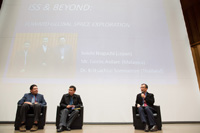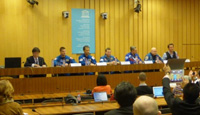JAXA Astronaut Activity Report, December, 2014
Last Updated: February 6, 2015
This is JAXA’s Japanese astronaut activity report for December, 2014.
Astronaut Kimiya Yui continues training for his upcoming long-duration ISS mission
Astronaut Kimiya Yui, who was assigned as a crew member for the Expedition 44/45 mission to the International Space Station (ISS), underwent training for a long-duration mission at the NASA Johnson Space Center (JSC).
During the training for EVA, Yui confirmed the pre-EVA procedure in a training facility called the Space Station Airlock Test Article (SSATA) that features the Quest Joint Airlock function.
Attired in a flight unit of the Extravehicular Mobility Unit (EMU), he operated airlock and EMU equipment in the depressurized SSATA.
He also reviewed the procedures of the Environmental Health System (EHS) operation. The EHS comprises each set of equipment to monitor the onboard environment, including the air composition, acoustics and radiation levels, etc.
Besides, he also learned how to use and maintain the US ISS toilet (Waste and Hygiene Compartment - WHC) and practiced with onboard crew training systems used to maintain operational skills during the long-duration mission. Furthermore, Yui obtained various baseline medical data for comparison to monitor bodily changes due to the long-term stay under microgravity.
Astronaut Takuya Onishi continues training for an ISS long-duration stay
Astronaut Takuya Onishi, a crew member for the ISS Expedition 48/49 mission, underwent training at Russia’s Gagarin Cosmonaut Training Center (GCTC) in early December, followed in the latter half of the month by training at the NASA Johnson Space Center (JSC).
In Russia, training was held for the Soyuz spacecraft and the ISS Russian segment. For the Soyuz spacecraft, he repeatedly simulated flight operations with a Russian cosmonaut. Via simulator, they practiced a series of operations from the launch of a rocket to docking with the ISS and atmospheric re-entry operations after undocking from the ISS.
Anticipating in-flight failures, they also practiced manual Soyuz spacecraft operations. For the ISS Russian segment, his training was focused on communication and tracking systems. After completing a series of training, he took an exam to confirm the acquired skills.
At the JSC, most of the training was held for medical operations. Onishi learned about a Crew Medical Officer’s (CMO) duty to be performed for other crewmates while in orbit, including medical-checkups and first-aid procedures. He also confirmed how to measure radiation levels using the EHS and how to use onboard exercise machines.
Astronaut Norishige Kanai participates in biomedical basics training
Astronaut Norishige Kanai participated in biomedical basics training at the NASA JSC.
During a week of training, followed by lectures and lab courses on cytology and bacteriology, he practiced ultrascanning himself, expecting that he may be required to do while in orbit. This training allowed him to gain a deeper insight into the significance of conducting onboard life science experiments and experimental techniques.
Astronaut Soichi Noguchi attends the 21st Asia-Pacific Regional Space Agency Forum (APRSAF-21)
From December 2-5, Astronaut Soichi Noguchi attended the 21st Asia-Pacific Regional Space Agency Forum (APRSAF-21) held at two venues in Tokyo.
The APRSAF is the largest space-related conference in the Asia-Pacific region; comprising space agencies, governmental bodies and many other related parties from the Asia-Pacific region; enhancing exchange of the latest trends and information on space activities as well as facilitating international cooperation. The forum has been held since 1993 and was held in Japan for the first time in nine years.

Noguchi moderating a session (Credit: JAXA)
Noguchi moderated a special session entitled “Space Exploration: ISS and Beyond-Toward Global Space Exploration,” held on December 4.
During the session, Noguchi was joined by Messrs. Mhd Fairos Asillam of the Malaysian National Space Agency (ANGASKA) and Kritsachiai Somasaman of the Thailand space agency (NSTDA) to discuss the benefits that ISS brings to each country and the foresights of future space exploration to be conducted by international cooperation.
During the forum, the activities of Kibo-ABC, a program intended to promote the utilization of the Japanese Experiment Module, “Kibo” by Asia-Pacific countries, were also reported.
Astronaut Soichi Noguchi participates in a press conference for a one-year expedition crew

News conference (Credit: JAXA)
On December 18 (local time), a press conference was held in the headquarters of the United Nations Educational, Scientific and Cultural Organization (UNESCO) in Paris to discuss the upcoming one-year ISS expedition mission by a U.S. astronaut and a Russian cosmonaut.
For the press conference, the one-year crew was joined by astronauts from each participating country. Noguchi represented JAXA astronauts and commented that the one-year mission was a magnificent achievement for biomedical and science experiments and bridged the gap between the ISS and far space exploration.”
Through a long-duration mission lasting a year, measures to maintain bones and muscle and the effects of a longer stay in microgravity on human bodies will be studied.
Such experiments will greatly contribute to the accumulation of knowledge for future moon, asteroid and Mars explorations. The one-year crew, NASA astronaut Scott Kelly and Russian cosmonaut Mikhail Kornienko are scheduled to commence their ISS stay from March 2015.



At the Johnson Space Center, various types of training are provided to enhance astronauts’ knowledge and skills that are helpful for space missions.
The training in which I participated this time concerned molecular biology. Feeling just as if I had returned to my college at medical school and partnering senior and fellow astronauts, we conducted experiments in a lab with a relaxed atmosphere.
A lot of research is now underway into immunology and microbiology on the Space Station following various measures to perform related experiments under microgravity. Considerable progress in life science research is expected with increasing numbers of universities and research institutions facilitating the utilization of the Station’s unique microgravity environment.